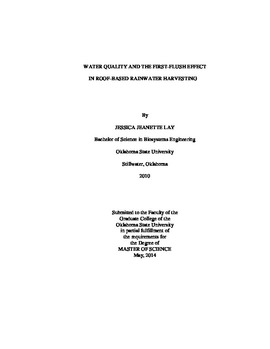| dc.contributor.advisor | Vogel, Jason R. | |
| dc.contributor.author | Lay, Jessica Jeanette | |
| dc.date.accessioned | 2015-06-17T20:06:42Z | |
| dc.date.available | 2015-06-17T20:06:42Z | |
| dc.date.issued | 2014-05-01 | |
| dc.identifier.uri | https://hdl.handle.net/11244/14959 | |
| dc.description.abstract | Rainwater harvesting (RWH) is a low impact development practice that involves the capture, diversion and storage of rainwater for later use. RWH can help alleviate demands on public water supply systems and promote better conservation practices in the public. Incorporating a first-flush diversion in a RWH system can drastically improve the water quality of harvested rainwater. The objectives of this research were to (1) evaluate the water quality of roof runoff from asphalt shingle, clay tile, metal, and tar and gravel roofs, (2) quantify a first-flush diversion based on a mass removal of pollutants, (3) evaluate a first-flush occurrence in roof runoff based on continuous conductivity measurements throughout a storm event, and (4) perform a pilot-study to determine if soils had potential for long-term accumulation of polycyclic aromatic hydrocarbons (PAHs) when watered with roof runoff that had no first-flush diversion. All runoff samples met "good" and "excellent" Oklahoma irrigation water-quality guidelines for conductivity, sodium adsorption ratio, and boron concentrations. While present, PAH concentrations in runoff samples were observed to be three orders of magnitude below recommended Health Based Screening Levels. An upper-confidence limit was constructed using the binomial probability density function to determine the minimum first-flush diversion required to obtain a 50, 75, 90, and 95% mass removal of total suspended solids and PAHs. Results from the soil pilot study indicated that there is potential for long-term accumulation of PAHs in soils receiving roof runoff that has no first-flush diversion. Approximately 70% of the soil samples that received roof runoff had higher PAH concentrations than the paired soil samples that did not receive roof runoff. Twenty-four to 100% of soil samples were also observed to exceed minimum human-health risk-based screening levels for individual PAH compounds in residential soils. Using harvested rainwater from rooftops to water lawns or irrigate gardens can potentially lead to long-term accumulation of PAHs in the soils when a first-flush diversion is neglected. Therefore, it is recommended that an appropriate first-flush diversion be included in a RWH collection system in order to reduce this potential of accumulation and improve the overall water quality of the harvested rainwater. | |
| dc.format | application/pdf | |
| dc.language | en_US | |
| dc.publisher | Oklahoma State University | |
| dc.rights | Copyright is held by the author who has granted the Oklahoma State University Library the non-exclusive right to share this material in its institutional repository. Contact Digital Library Services at lib-dls@okstate.edu or 405-744-9161 for the permission policy on the use, reproduction or distribution of this material. | |
| dc.title | Water Quality and the First-flush Effect in Roof-based Rainwater Harvesting | |
| dc.type | text | |
| dc.contributor.committeeMember | Belden, Jason B. | |
| dc.contributor.committeeMember | Brown, Glenn Owen | |
| dc.contributor.committeeMember | Storm, Daniel E. | |
| osu.filename | Lay_okstate_0664M_13333.pdf | |
| osu.accesstype | Open Access | |
| dc.description.department | Biosystems & Agricultural Engineering | |
| dc.type.genre | Thesis | |
| dc.subject.keywords | first flush | |
| dc.subject.keywords | pahs | |
| dc.subject.keywords | rainwater harvesting | |
| dc.subject.keywords | roof runoff | |
| dc.subject.keywords | water quality | |
